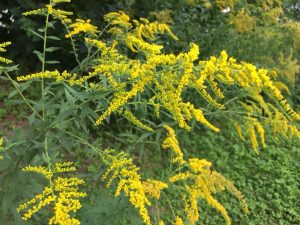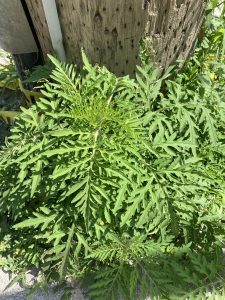
For many, late-summer is hailed by runny noses, itchy eyes, and irritated throats. Plenty of colourful flowers are in bloom at this time of year, including Queen Anne’s Lace (a.k.a. Wild Carrot), New England Asters, and Blueweed (a.k.a. Viper’s Bugloss), but the new bloom on the block when these allergies hit is the conspicuous bright yellow flower of the goldenrod, so it often gets blamed for allergies.
But it’s not the culprit.
Common Ragweed is.
 Common Ragweed is wind-pollinated, so its pollen is light and airborne. It typically shares habitat with goldenrod and blooms at the same time, but its small green flowers aren’t as obvious as goldenrod’s bright yellow ones, so goldenrod almost always takes the blame for allergies.
Common Ragweed is wind-pollinated, so its pollen is light and airborne. It typically shares habitat with goldenrod and blooms at the same time, but its small green flowers aren’t as obvious as goldenrod’s bright yellow ones, so goldenrod almost always takes the blame for allergies.
There are many species of goldenrod, all of which are insect-pollinated, meaning their pollen is large and too heavy to be blown by the wind. Although goldenrod pollen can cause allergic reactions in some, that’s rare, and would generally have to come from contact with the plant through handling or sniffing. Stop and take a look at a goldenrod patch on a hot summer day, and you’ll find its gorgeous yellow flowers are used extensively by pollinators.
Because pollinator populations are plummeting, allowing flowers like goldenrod to remain, rather than viewing them as weeds and removing them, will support the pollinators, beautify your garden, and not cause your allergies 🙂
Note: This photo of Ragweed was taken in early July, before it went into bloom. Its flower is a thin spike growing from the top-centre of the plant that is covered with tiny flowers the same colour as the leaves.
